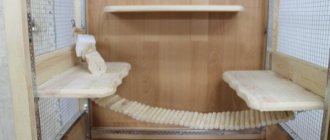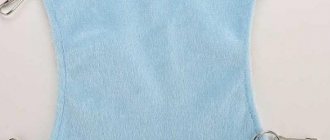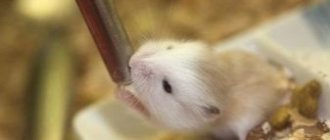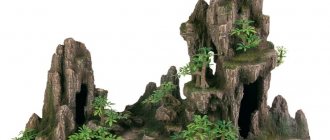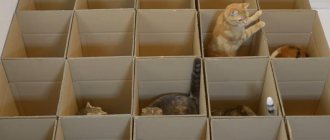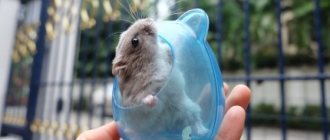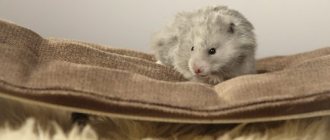What kind of cage should a chinchilla have?
In the “classic” version - a male and a female - the minimum permissible dimensions of the structure are: 90x90x50 cm.
For chinchillas to live freely in the summer, a special enclosure is equipped. It is placed on a personal plot or balcony, if space allows. The dimensions of the enclosure for keeping chinchillas at home are selected arbitrarily, depending on the availability of free space.
For this purpose, frames are made, which are covered with metal mesh on top. The house must be screwed to the floor or wall with screws. Thick boards or ceramic tiles are laid at the bottom of the enclosure, on top of which straw and sawdust are poured. To prevent uninvited guests - rats or mice - from entering the home, the lower part of the house is sheathed with galvanized iron to a height of 50 cm.
If the chinchilla enclosure is located on a personal plot, it is installed on a foundation. This should be a spacious room measuring 3x2x2 m. The front part can be made of metal mesh, and the side walls can be lined with wood. This will help protect the animals from drafts, which are poorly tolerated by rodents. A roof covered with slate or roofing felt will protect chinchillas from rain.
The chinchilla is a fur-bearing animal whose maximum length including tail does not exceed 50 centimeters.
This is a very peaceful and tactile animal, which not only never bites, but on the contrary can sit in the owner’s arms for a very long time, and, like a tactile maniac, “absorb” the affection of its owner in the form of stroking and sniffing.
Chinchillas come in several varieties:
- small long-tailed;
- coastal;
- short-tailed;
- big.
In the wild, they all live in rocky, arid regions, at altitudes ranging from 400 to 5,000 meters. They choose rock crevices or space under stones as shelters.
In the absence of these, they dig their own minks. In their natural habitat they feed on various herbaceous plants, mosses, lichens, cacti, shrubs and tree bark. They can eat insects from animal food.
Before you start creating, you need to highlight the main parameters of a home for chinchillas. After all, if it is properly equipped, the animal will feel very comfortable. Any pet needs its own home, but for this it is not at all necessary to go to specialized stores and buy an expensive and, as a rule, not convenient for a pet cage.
You can design a high-quality cage yourself, based not only on the needs of the animal, but also on the design of the house or apartment. Indeed, due to the certain shapes of the room, a do-it-yourself cage can perfectly complement the room. But first you will need to measure everything and make drawings of the house.
When making a drawing, it is necessary to take into account the dimensions and external characteristics of the house. You should also consider how many chinchillas will live in it. For example, if there is only one pet living in the house, then you need to immediately decide whether to buy another one, perhaps for mating. After this, the correct calculation should be made and if there are offspring, then there is a place for them.
Based on the future design, one cage can contain from one animal to several. It is only important that there is free space.
If you decide to get such an exotic animal for our countries, you must take into account all the parameters so that the animal feels “at ease.” Since any rodent needs a home, it is not at all necessary to run to the pet store and buy the most expensive cage. Even a high-quality design can be made with your own hands. Moreover, you yourself will draw up drawings with the dimensions that you need, and will not buy what is available in the store.
When developing a drawing, you should consider not only the dimensions and how the pet cage will look in your home. Consider the number of rodents. If you have one chinchilla, then think about the future - you may want to happen to another animal, so plan in advance the place in the cage for the offspring.
Chinchillas are animals that are listed in the Red Book! On many farms they are bred in order to later obtain valuable fur. These animals appeared in South America. They live in dry and rocky areas. Some of them can live up to twenty years.
Chinchillas feed mainly on plant foods and various insects. The activity of animals is highest at night. They began to be grown for valuable fur at the beginning of the 19th century. These animals can be kept both at home, as a pet, and on farms to obtain valuable fur.
The body of chinchillas reaches from 20 to 38 centimeters in length.
Pregnancy in chinchillas lasts 120 days, and then from one to six small animals can be born.
All these features need to be taken into account when choosing housing for pets.
You can have no more than two chinchillas in an apartment, but this will require a cage for them to live there. Knowing the size of the chinchilla cage, you can easily make it yourself! If your plans include the idea of having several animals, you will need a special enclosure. Here the question arises about what cage size for a chinchilla is minimal, optimal and ideal for farming.
It will no longer be possible to breed chinchillas for fur in a simple city apartment, because a whole family of rodents will not fit in one cage. They will need a specially equipped enclosure. On farms for these animals, enclosures are installed that do not block access for males to females, because if they do not meet, offspring will not appear.
These cute creatures will live comfortably in places with temperatures of about 20 degrees. The animals are very sensitive to heat and less sensitive to cold. Make sure that the air temperature does not drop below zero!
We suggest you read: Non-contagious diseases of bees and their treatment
Chinchillas will not live on metal bars, so place hay or sawdust on the bottom of the cage.
As mentioned above, you can have chinchillas in an apartment or in a house. But it is worth remembering that it will not be possible to have more than two individuals. You will definitely need to purchase a cage for your unusual pets that will be comfortable and of a suitable size. 14-20 degrees Celsius will be the most suitable temperature for this type of rodent to live. Remember the most important thing: they absolutely cannot tolerate drafts or sunlight that falls directly on them.
Chinchillas that are bred at home very quickly get used to people and become completely tame. They will not be afraid of people. They will be very sweet, kind and friendly. But forget about the fact that they can be let out for a walk around the apartment. Rodents are natural chewers, so keep them in a cage. The size of the chinchilla cage must be chosen correctly to ensure the pet’s comfort.
The size of the chinchilla cage should be such that the animal easily fits in there and can live comfortably.
Many experts say that cages are most suitable for this type of animal. But in order for rodents to feel comfortable there, you need to know what size a chinchilla’s cage should be. It's not that difficult to figure this out. So, what is the optimal cage size for chinchillas?
You choose a home for the animal. And you need to select the size of a cage for chinchillas according to the animal, and not according to your taste, because the main thing is that he feels cozy and comfortable in it. The animals spend most of their lives there, so don't skimp!
In addition to the question of what size a chinchilla cage is, you also need to ask yourself what should be inside it.
First, come to the store and choose a spacious, hygienic design. The passage to the cage must be simple. Do not leave chinchillas in places where there is constant noise or in isolated areas. The animals will not be able to relax, which means they will not be able to rest either. All this will not lead to good things.
Since the animals cannot stand the sun's rays, they cannot be placed near the window. Remember: if you want to sleep at night, do not put a cage with chinchillas in the bedroom, because their greatest peak of activity is at night.
Among the cages, the most popular are the ones with a retractable tray, as they are quite easy to care for.
So, the minimum cage size for a chinchilla is 50 cm by 70 cm by 50 cm. But this is still not enough. The optimal cage size for chinchillas is 84 cm by 50 cm by 40 cm.
Having purchased housing for animals, do not rush to place them there. First, add special shelves to the cage so that the animals can run somewhere. Place a food bowl and a drinking bowl. Some chinchilla owners make a house in their cages. If you have such a desire, then buy it, it won’t hurt.
If you will breed animals in order to later obtain valuable skins from them, then the size of a standard farm cage for chinchillas should be much larger than usual. There should be special tunnels through which the male can run to the females.
The cage should also have shelves that will be used by the animal for movement. A drinking bowl and food bowl must be present. You can also put up houses, but under no circumstances should they have a bottom!
The bottom of the cage can be covered with sawdust or straw, so the animal will be much more comfortable.
If you don’t want to buy a cage for your chinchilla, you can make it yourself! All that remains is to find out the dimensions of the structure and build it with your own hands. It won’t be difficult to make a cage, the main thing is to want and try. As an example, you can use the photos given in the article.
You should know that chinchillas practically do not shed, and if they do, it is only from fear or some kind of excitement. There is no need to wash the fur with water. Nature intended that chinchillas clean their fur with volcanic dust. At home, of course, there is no such dust, but it can be replaced with sand. It can easily be placed in a cage.
How to set up a chinchilla cage
To make your pet’s home as cozy and comfortable as possible, you need to take care of the attributes. The most important items are the drinking bowl and feeder. The drinking bowl must be a drip bowl, in which case the animal will not wet its face and paws in the water. You should not take plastic products, because... The chinchilla tries to chew everything. The feeder must be stable. It is better to choose products made of ceramics or metal. Hay plays a major role in the animal’s menu, so you need to buy hay. It is a wooden product with metal rods attached to the wall.
There must be a secluded place in the home. To do this, you can use a special house with holes and a roof. It can be purchased at any pet store. If the size of the cage does not allow you to place a house there, you need to attach a number of shelves. They are located at different levels. A hammock is often used as a replacement for a house. You can buy it or make it yourself. The material for it must be durable. A piece of fabric is folded into several layers and stitched. Holes are made at the corners through which ribbons or chains are passed. The finished product is suspended from the ceiling of the cage.
An additional accessory for your pet's home is a bathing suit with volcanic sand. Due to the lack of sweat and sebaceous glands, chinchillas take sand baths. To prevent the animal from falling into depression, you need to think about how to arrange an area for active recreation. To do this, buy ladders, tunnels, a running wheel and a plastic ball. If the litter is not used as a toilet, you need to purchase a tray.
Dimensions of housing for one pet
A cage is a whole world for a chinchilla. It should be comfortable, spacious, hygienic. When buying a “house” for a pet, you should not focus on your taste. It is better to choose a larger structure so that the chinchilla can move freely on it.
To keep one pet, the minimum cage size is 70x70x50 cm. However, experienced breeders recommend equipping a spacious home measuring 90x50x40 cm for a pet chinchilla.
When purchasing a cage, take into account the following recommendations:
- The design should have a retractable tray: it allows for hygienic cleaning as quickly as possible.
- The most suitable materials are wood and metal. So, the structure itself may be made of wood, but have metal bars on the side walls and doors.
- It is allowed to keep an animal in a metal cage, which is cheaper than its wooden counterparts. However, such a product has a number of inconveniences. The movement of an active animal inside the structure is accompanied by noise; in addition, sawdust and food get into the room through the bars.
- The distance between the rods should not exceed 20x20 mm so that the animal does not get hurt or harm itself.
- There must be air circulation in the home, otherwise the animal’s fur will deteriorate and it may get sick. Display cases sold in pet stores are usually equipped with a window through which the house is ventilated. Please pay attention to this detail when purchasing.
We suggest you read: How to give a cat an enema at home
Inside the cage you will need to install:
- Wooden shelves located at different levels;
- House with several entrances;
- Drinker, feeder, hay barn;
- A sand bath for bathing.
If the cage has enough space, it can accommodate play tunnels and a wheel for active pet activities.
After purchasing a chinchilla, you will have to settle into its new home. The animal needs time to become familiar with every corner and the people around it. He doesn't like strangers, but he misses his own people and demands communication. Sometimes even turning on the TV can contribute to this.
Chinchilla in a cage
Many breeders train them to use a litter tray so as not to accumulate dirt in inappropriate places. Food should not be poured in excess; at first, one spoon is enough for your pet. You need to feed in one period defined in the day, the most appropriate time in the evening. The owner usually monitors the pet’s needs and supplies food in the amount that is enough for him.
As soon as the animal is released into the cage, it is better not to bother it with your attention for a couple of days and let it adapt to the new place. It takes him a long time to get used to other people’s smells and evaluate the situation. In a space protected from strangers, he is calm, the pet will study, in the time given to him, all the people approaching the cage.
In 4 days we will have our first close contact. It is required to open his home and provide him with the opportunity to independently move into the palm of his owner. This will not work right away; at first the animal will sniff your hands for a long time, run deep into the house, and return again. You should not forcefully pull him out of his shelter; curiosity will prevail over the fear of the unknown, and the pet will go for a walk. These animals perfectly understand human speech, if you talk to them, indicate every action that it is time to eat or walk.
Proper care, neatness in the room, periodic changes of bedding and water will pay off in the attitude of an amazing animal and its stable state of health.
Basic requirements for the cage
A properly equipped cage is the main condition for the good health and mood of your pet. Of course, you can buy a ready-made house, but one made by yourself will be much more comfortable, because you will put all your love and warmth into its construction. You can choose the appropriate sizes, taking into account the dimensions of the apartment or house. In addition, a homemade design will significantly save the family budget.
What kind of cage should a chinchilla have? First of all, it must be safe so that the animal does not get hurt or damaged in it. It is also worth considering practicality and a sufficient amount of space for the animal to spend its active time.
For construction, you can use old furniture. The size of the house is calculated based on the number of individuals. For one, the minimum cage size is 80 x 70 x 60 cm, but it is better to make an enclosure for two at once if in the future you decide to buy a chinchilla partner. For each subsequent animal, the dimensions of a single dwelling are multiplied by the number of animals. The cage is made from environmentally friendly materials, without the use of paint or varnish. The presence of sharp corners, protruding screws, nails and other fastening elements is not allowed. To properly make a cage, you need to familiarize yourself with some recommendations.
- It is better to make the cage frame vertical. Chinchillas love to conquer heights and jump from them. A horizontal low cage will be uncomfortable and cramped.
- The internal shelves are made removable, because... the animal loves to chew on everything and from time to time they will need to be replaced with new ones.
- A metal mesh is inserted into one or two side walls of the display cage. This helps improve air circulation and maintain the microclimate inside the home.
- Glass doors will help keep the area around the cage clean.
- The cage must be closed, because chinchillas like to stick their nose everywhere and can climb into unsafe places in the apartment.
- When making a cage from metal rods, make sure that the distance is no more than 2 cm. The animal can slip into large gaps and get injured, and the kids can run away.
- The floor is made retractable. This will make cleaning the cage easier.
What does a DIY chinchilla cage look like?
When choosing materials for making a home, weigh the pros and cons of each of them. The metal frame is easier to clean and transport when folded, but it does not insulate noise at all. Rodents like wood more; they like to sharpen their teeth on it, but the disadvantage of such material is that it absorbs moisture and odors. It is better to give preference to a combined design.
Let's go to my place?
And before purchasing this fur buddy, you should take into account some of the nuances that you may encounter. A chinchilla is not an aquarium fish that will be comfortable in a liter of water. Providing proper conditions for keeping such a rodent can significantly lighten your wallet.
In terms of activity and playfulness, chinchillas are at their maximum when they live in families. And if you already have one individual, you should think about creating a small family for him in the form of a cage partner, or a couple. And if you manage to create optimal conditions for the animal to live in your home, then it can live a long and happy life.
Care, nutrition, walking and affection play a very important role in the life of a chinchilla, but the most important factor is still its living space. And if you want to go beyond the cages that stores provide, or save money, then with a little patience and not a lot of time, you can make a cage yourself right in your home.
Chinchilla cage
Along with breeding rabbits, many began to breed chinchillas. They are easy to care for, suffer little illness, and reproduce well. Chinchillas get along well with children, which is why many people get them instead of a cat, dog or parrot. The author of the homemade product also started breeding chinchillas, and to keep them he made a cage from an aluminum profile.
Tools and materials Aluminum profile; Accessories; PVC sheet; Fasteners; Glass; Plywood; Self-adhesive film (or laminate); Plexiglas; Metal mesh; Electric jigsaw; Drill.
The author purchased the aluminum profile and fittings from a store selling commercial equipment.
The connecting element for attaching the profile to each other can also be purchased at the store, but the author decided to make it himself. This is a magazine mount.
In order to make the mount himself from PVC sheet, the author cut out a rectangle 40 by 22 mm. The thickness of the rectangle is 13 mm. I removed two grooves from the end of the rectangle along the edges so that there would be a 5 mm shelf between them. Drill a through hole in the middle from the end for the bolt.
Next, the author installs the connecting elements. The cage stands are made of a semicircular profile. The rectangular profile is installed transversely. A fastener is installed in the semicircular profile, in the place where it will connect to the rectangular one. The cleaning cage underneath must move, so the wheels are screwed to the bottom of the posts.
The bottom and back of the cage are covered with plywood. Since the thickness of the plywood used by the author is less than the width of the profile groove, the contact area had to be sealed with rubber. For those who will make a cage following the author’s example, he advises using 5mm plywood, which corresponds to the width of the profile groove.
The connection points are secured with screws.
Cut out the bottom of the cage from a 10 mm sheet of plywood. Self-adhesive film is glued to the plywood.
To prevent chinchillas from chewing the floor, plexiglass is placed on top.
The roof and side walls are made of mesh. The thickness of the rod should be from 0.9 mm, the cell should not be more than 12 by 25 mm. The roof is assembled from the profile. Having cut the mesh to size, the edge is bent and inserted into the groove of the profile. Installs the roof. Closes the two side walls in the same way. Screw metal corners to the walls, at a vertical distance of 20 cm from each other. Shelves are installed on them, cut out of clapboard.
The author decided to make the doors from glass. Having measured the doorway, I cut out two doors from 5 mm glass. I installed them in the opening on special hinges. Installed a lock.
A well-ventilated, spacious, easy-to-clean shelf for chinchillas is ready. Source
Become the author of the site, publish your own articles, descriptions of homemade products and pay for the text. Read more here.
Jail break
No matter how much you love your animal, no matter how much it likes its home, do not forget that your pet is a representative of the rodent family. And attempts to chew through a dwelling made of not very durable material should not be regarded as dissatisfaction with the house, even if it is spacious and equipped with many toys and whatnots and all sorts of other entertainment.
Curiosity is a characteristic feature of these animals, and combined with the constant need to chew something, a new entrance or exit may appear in your animal’s house.
CAGE FOR CHINCHILLA. CHINCHILLA CAGE DIAGRAM
A cage made of welded galvanized mesh with a cell size of 2x2 cm is best suited for keeping chinchillas. The minimum cage size for one animal that fur farmers use is 30x50x40 cm. The female can share this space with the male or with the cubs for some time, but if there are several kids, then the family will be a bit crowded.
It is more convenient to remove the chinchilla from the cage with both hands, so the door located on the front wall is quite wide and high, occupying almost its entire area. At the bottom of the cage there is a retractable tray made of galvanized iron with sides about 4 cm high. Wood shavings are poured into the tray, which are changed as they become dirty. On the side of the chinchilla cage there is a box measuring 20x50x20 cm, made of the same galvanized iron. It has a transverse partition, two holes on both sides, and a lid on top. Fine sand is poured into the box, in which the animals love to swim - they keep their fur in good condition.
The box is placed between two adjacent cells. When you move it forward a little, the holes in the side walls coincide with those in the side walls of the cages, and the chinchillas have access to the sand. At the end of the sand procedures, after 10-15 minutes, they usually knock on the box, and when the animals return to the cage, they push it into place.
Since the cages in the room are in four tiers and close to each other, the feeders and drinkers are installed on the same front walls. Small hopper feeders are right on the door, and nipple drinkers are on the side of it.
In addition to all of the above, inside the cage at the back wall there is a shelf made of mesh for animals to rest, and in the upper corner of the front wall there is a corridor 12x12 cm wide.
Several cells are connected by one corridor, each of them has a round hole with a diameter of 7 cm. This size is enough for a male, walking along the corridor, to visit some female. But the females cannot get through the corridor into the neighboring cage - the plastic collar put on each of them prevents them from doing so. This is the polygamous keeping of chinchillas, when one male serves 2-6 females.
The openings leading from the corridor to the cages are equipped with latches - so that a very lively male does not disturb the female with newborn cubs. When they grow up, after 2-3 weeks the valve can be opened, and the male will again have access to his family. Chinchillas live as if in one big dormitory - they can run along the corridor wherever they want, adult animals usually do not offend them.
When talking about the design of cages for chinchillas, you should also pay attention to their location in the room. The temperature in it should not rise above 25°, and the air humidity should not exceed 70 percent. And, of course, drafts should not be allowed.
It is best to place the cages along the walls so that direct rays of the sun from the window do not fall on the animals. If the window is opened for ventilation, the door to the room must be closed. In this case, it is advisable not to place the cages directly on the floor, because the air draft is strongest at the bottom. If it is difficult to hide from direct sun and drafts in your room, then you can use light cardboard or plywood barriers.
Feeding the chinchilla
Fur breeders keeping chinchillas have tried a variety of foods. They also provided mixed feed with granulated alfalfa and hay brought from abroad. We prepared our own compound feed of a given composition and diameter on our own granulators, in order to reduce hay losses, and gave it in the form of briquettes. In the end, we settled on a homemade cereal mixture. They didn’t invent a recipe, they just try to stick to the composition that is included in the feed on chinchilla farms in Poland.
A chinchilla eats little per day - only 1 tbsp. a spoonful of feed, but if the livestock is large, then about a bucket of feed will be needed per day. In one large container mix 5 buckets of crushed alfalfa pellets, 1 bucket each of wheat grits, rolled oats and bran, 4/5 buckets of corn grits and less than half a bucket of flax seed. Add 3-4 kg of milk powder, 1 kg of soy protein, a little less chalk, a couple of tablespoons of salt. Vitamin Dg (or trivit), rabbit premix “Ushastik” and the vitamin mixture are diluted in 1 glass of unrefined sunflower oil and also added to the mixture. Moreover, vitamin oil is first poured into rolled oats, which chinchillas love most, and only then the oatmeal, which has absorbed the vitamins and oil, is mixed with the rest of the cereals.
With this diet, the chinchilla not only feels great, but its fertility also increases noticeably. If there are usually two cubs in a litter, then with such a diet the birth of three or even four babies has become almost the norm.
Optimal size for keeping for breeding purposes
Many keep rodents for commercial purposes. If a large number of pets live in the household, a structure of several compartments will be required.
For breeding animals, a block designed to accommodate a family of rodents is assembled. It consists of several small cells, along which a 20 cm wide corridor runs. It allows the male to visit several females at once, which are isolated from each other. To prevent females from leaving their home, you will have to purchase an additional accessory - a collar.
The minimum size of a cage for a chinchilla for industrial breeding is 50x40x40 cm. It is important to think in advance about the location of the cages so that they have easy access and do not take up much space.
On farms, cage sizes are selected depending on the size of the rodent family. So, 1 male and several females are placed in one room - from 4 to 8 females.
Chinchillas do not smell, while many other rodents require constant bedding to keep the smell from getting stronger.
Do not take chinchillas from random breeders, as no one will guarantee that the animal is healthy. The best option is to take the animal from a nursery.
Cute and funny chinchillas are becoming increasingly popular for apartment living. The animals are unpretentious, have a funny plush appearance, and a kind character. However, they require a special cage to keep them. Some breeders prefer a self-made design to store-bought products, which has a number of advantages.
The chinchilla is a curious and very intelligent animal, and also active and playful.
Before you start arranging a cage for an animal, you need to think about the place where the cage will stand, as well as a bedside table for storing food.
Before buying a pet, you should pay attention to the fact that the chinchilla is a long-liver. And with good care, it will delight its owner for up to twenty years. Another important point is that animals get bored when alone, especially if the owner does not have enough time for daily and full communication with his pet.
Therefore, one day the question may arise about buying a pair for your ward. The couple does not have to be of the opposite sex - same-sex animals get along well with each other. This point should be taken into account when choosing the size of a cage for a chinchilla. It is also worth remembering that many chinchillas are most active in the evening and at night, which means that the cage with the animal should not be installed in the bedroom. Otherwise, there is a risk of waking up from the chinchilla’s loud and not entirely pleasant cry, fussing in the cage, or a loud crunch.
We invite you to familiarize yourself with: Cattle barn: do-it-yourself cattle barn
SILVER CHINS
In the topic of keeping chinchillas, we have already considered the issue of polygamous and monogamous breeding of chinchillas. In it, we touched upon the discussion of cells in one way or another, but we talked about it superficially, without going into detail, in the format of only that article. Now we will try to discuss this issue in more detail.
So, let's start with simple initial data. The chinchilla is a very active and agile animal, in some ways even reminiscent of a squirrel in behavior; it is not for nothing that it is also nicknamed the “Chilean Squirrel”. In this regard, for a comfortable stay, a chinchilla requires a spacious cage. Moreover, the height of the cell is more significant than its dimensions in depth and width. The average size of a cage for one couple is 60x60 cm and a height of 70 cm. Anything larger is welcome. The cage should be equipped with 2-3 shelves on which it will be convenient for the animals to jump. If the cage is large, then it makes sense to install a drum wheel in the cage. Chinchillas will gladly appreciate your concern for their physical fitness and will amuse you with their training.
Now let's talk about the design. If you keep a chinchilla in an apartment, then closed cages are best; this will save your home from heavy debris and the animals from possible drafts. These can be homemade designs, where an old cabinet is used as a basis, or laminated chipboard panels. Holes are made on the side or rear walls and covered with a grill or mesh for ventilation. This is a mandatory condition, since otherwise there will be increased humidity in the cage, which will lead to the development of fungal diseases. The front door can be either made of transparent glass, or made of mesh installed in the frame, or a combination. Which is more convenient for installation from the outside of the nipple drinker door and hay tray. It is best to make a tray with high edges at the bottom of the cage. This may be a metal or plastic tray, but then it is worth protecting the upper edges with an aluminum corner from gnawing. It is advisable to do the same with the shelves. Otherwise, the shelves will very quickly turn into geometric shapes of arbitrary shape. It is also worth thinking about protecting all protruding corners where teeth can only reach, so that the animals do not eat the glue from the chipboards. If a closet was chosen as the basis of the cage, then depending on its height, it can make cages for two, or even three or four shinsho families.
These are the display cases we made ourselves when we just started breeding chinchillas of rare colors. The basis was taken from sheets of laminated chipboard, glass doors were made from picture frames, which at that time were sold inexpensively in IKEA stores.
You can also purchase ready-made cages - display cases made from aluminum profiles similar to those used in commercial equipment. The sizes and designs of such display cases vary, but it is advisable to choose designs with a removable tray. Prices for such structures are not cheap and are rarely less than 10,000 rubles.
The photo shows single display cases, but there are designs for two or even three chinchilla families, with drawers and cabinets for provisions and equipment.
The next type of cages are industrial cages of domestic or imported production, welded from stainless, galvanized, or painted wire. These cages can come in a variety of sizes and may have removable, pull-out trays or clip-on trays. Such cages can be equipped with plastic shelves, ladders and houses. The only negative is that there will be dirt and dust all over the house. It is also worth considering where to place such a cage, since chinchillas are afraid of drafts and direct sunlight. It is also worth paying attention to the distance between the rods and their rigidity. The bars should be no wider than 1.5 cm, otherwise there is a chance that newborn children may go AWOL from the very first days.
Well, the last type of cells are cells made by farmers. Such cells can be of different sizes and designs, including polygamous ones of the 2+1 or 4+1 type. The only thing that unites all these cells is that they are made of galvanized mesh. The optimal cell size is 16x16, or 19x19 mm. The wire thickness is at least 1.4 mm. Newborn children can already fit into a larger cell size in the first days of life. There are also undoubted advantages in such cages, since they are all equipped with a removable tray, a metal bath and mesh shelves, a built-in feeder, and there are models with a metal house. You should pay special attention to the shelves. If they are made not of wood or chipboard, but of mesh, then in order to avoid inevitable fractures of the legs, the sides and edges of such shelves should be covered with a wide metal corner. This will protect both from shelf sagging and from accidental paws getting into the outermost cell during jumps. As a rule, such cages are more convenient to maintain, but are smaller in size and are not suitable for placement in an apartment, unless a separate room is allocated for chinchillas.
SilverChins
But I can!
Having gathered your thoughts and pretended to be smart, you can begin planning the construction of the cage. Although the process is not very complicated, it is worth approaching it quite seriously and carefully so as not to redo your invention.
Here is a brief guide on how to plan the technical process for building a cage:
- First you need to prepare drawings of the future cage, taking into account the dimensions and accessories that will be inside.
- We free up the space where the cage will be located in the future.
- We make the main frame of the product, which will be made of metal tubes. These tubes will be connected to each other with corners and fixed with screws.
- We make a plan of the housing compartments. There should be separate areas for eating, for games and a separate area for sleeping.
- Using a welding machine, we attach the bottom of the cage to its main structure. For convenience, it is better to cover the bottom with wood.
- Next we attach the cage walls.
- Cleaning a rodent's home is quite a common task, so for convenience the roof of the home should be removable.
- Since our animal is quite boisterous and jumping, all parts and equipment inside the cage must be securely fastened.
Chinchillas are clean animals and love to take sand baths, spinning in them and cleaning their fur. Equip a cage with a container into which you can pour sand. The sleeping compartment can be equipped with hay.
You don't need to have any special skills to make your pet a comfortable home.
It's worth remembering that:
- the cage should be spacious;
- equipped with a feeding trough, drinking bowl and toys;
- divided into zones;
- qualitatively processed.
And if you follow just a few rules, the question of how to make a rodent cage with your own hands will not be so unanswerable for you.
How to make a chinchilla cage
If you have at least minimal carpentry skills, the process of making a house for a chinchilla will not be difficult. For those new to construction, it is better to use ready-made drawings or study video information on this topic. Armed with knowledge, you can get to work.
Required materials and tools
To construct a cage for a chinchilla you will need:
- metal grid;
- steel tubes;
- metal sheet for the floor;
- plywood sheet;
- loops;
- grinder for metal;
- screws, screws, nuts;
- welding.
To make a cage you will need a mesh
Since a welding machine will be used, do not forget to protect yourself.
Drawings and layout of zones
Having decided on the number of animals that you plan to house, it becomes clear what size their home will be. When drawing up a schematic representation of the future cage, think about where the playroom, bedroom, feeding trough and toilet will be. These zones should be in different places. Shelves, ladders, wheels and other accessories also take up space. Include their parameters when calculating the frame size. Remember that a chinchilla should not be cramped in its home, and a sufficient number of paraphernalia will help organize the animal’s leisure time.
Step-by-step instruction
When the drawing is ready and the necessary tools are at hand, you can begin marking and subsequent assembly of the material.
- For the frame, metal tubes are cut based on the required dimensions. The elements are fastened together with angles and screws. At this stage, you can immediately mark the future location of the shelves and sections.
- A bottom made of sheet metal is welded from below. Boards or plywood are laid on top of it.
- Pieces are cut out of the mesh and attached to the tubes using angles and screws.
- The roof of the cage must be opened or removed completely. This will make the cleaning process easier. It is made from steel pipes and mesh. It is better to close the cage with a lock, since a chinchilla can open a regular latch.
When the home is built, you can think about its arrangement.
Instructions for making a cage for yourself
To learn how to make a display cage with your own hands, watch the video.
[Hide]
How to care for chinchillas? In what conditions are they comfortable? What is the optimal size
So, before you start making the cage, you need to decide on the material. Plastic, chipboard or DVD will not work. Dirty wood infected with fungi is also not suitable. Artificial materials are also unsuitable for making cages for animals such as chinchillas. When making a cage, pay attention to various small items, such as bolts, nuts, and so on. They must be securely fastened. They are small in size, which means that animals can easily swallow them, which is very bad.
The advantage of such a product is that it can be made from materials available in the house and according to your own sketches. Remnants of old furniture are suitable for the floor and ceiling, and a metal frame is required for the side walls and ceiling.
If you decide to make a chinchilla cage yourself, pay attention to the details:
- You cannot use plastic or chipboard as the base material;
- The pallet is made of steel sheet, and the side walls and facade are made of metal mesh;
- All bolts and screws must be removed from the cage so that the animal does not accidentally swallow them;
- All parts inside the house must be securely fastened so that they do not fall and injure the chinchilla;
- The wood used is dry, not infected with fungus and parasites.
A homemade design has a number of advantages. Its cost will be cheaper than a purchased analogue, and in addition, you won’t mind throwing away the cage if it’s unusable. You can choose the safest materials for assembling the product. Cheap Chinese cages made of synthetic material will last less time.
However, before making a house you will have to spend money on consumables. Also, the master needs certain skills, otherwise it will take a lot of time to assemble.
Step-by-step instruction
First of all, you need to prepare the tools and consumables that will be used during work. After this, you can begin manufacturing. Do-it-yourself chinchilla cage - step-by-step instructions:
- Cut out the back wall of the display case from the furniture board. It must be solid, since it is on it that all accessories (feeder, wheel, etc.) are attached. It also protects the wall of the apartment next to which the cage stands from destruction - a curious and at the same time active chinchilla is capable of tearing off the wallpaper, chewing the plaster, and tearing off the paint. If you plan for it to stand in a corner and be in contact with two walls, you should cut out both the back wall and the side from a solid panel.
- Cut out the ceiling from the furniture board and, leaving 5-10 cm on each side, cut out a ventilation window with a jigsaw. Subsequently, it will be covered with a mesh. This part can also be assembled from four planks, carefully connecting them together.
- Make the bottom part. It is advisable to make it in the form of a drawer that acts as a tray - this will make cleaning easier, but in this case the floor should be mesh. Garbage and waste will fall through the cells, and the person caring for the chinchilla will only have to pull out the drawer to pour everything in it into a garbage bag.
- Cut strips about 5-10 cm wide and equal to the height of the display case, in the amount of 4 pieces. They will serve as side supports.
- Assemble the frame of the structure by fastening together the parts mentioned in paragraphs 1-4. After this, you can begin installing the glass and mesh.
- Cover the top ventilation window and side walls with mesh. This is done in the following way: from the inside, along the entire perimeter, the mesh is attached with staples using a stapler or screwed with self-tapping screws, and then the joints of the mesh and wood are covered with aluminum strips. This installation option protects the animal from injury from sharp edges.
- Attach the glass doors and insert glass into the side walls, if this was planned. For convenience, the doors can be made double not only vertically, but also horizontally. Then you won’t have to keep the entire display case open to clean, feed or replace accessories.
- Seal all joints with sealant. To prevent your chinchilla from getting poisoned if he decides to chew it, you should use a non-toxic transparent sealant for aquariums.
After this, the cage is ready for use.
All wooden parts must be sanded well before fastening, otherwise the animal may injure its paws.
